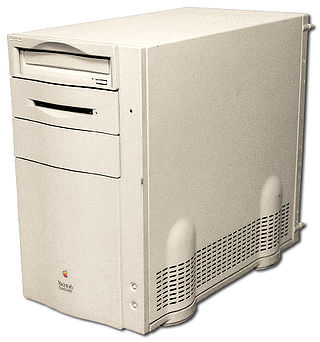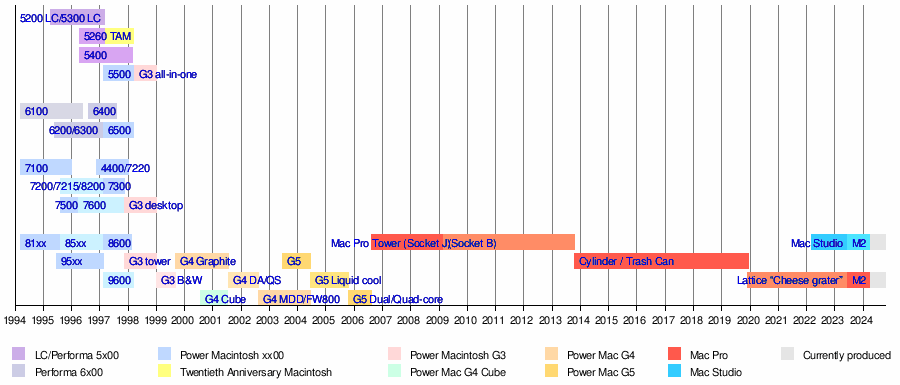
The Power Macintosh, later Power Mac, is a family of personal computers designed, manufactured, and sold by Apple Computer, Inc as the core of the Macintosh brand from March 1994 until August 2006.

The Power Macintosh 8500 is a personal computer designed, manufactured and sold by Apple Computer from August 1995 to February 1997. Billed as a high-end graphics computer, the Power Macintosh 8500 was initially released with a 120 MHz PowerPC 604, and unlike earlier Power Macintosh machines, the CPU was mounted on an upgradeable daughtercard. Though slower than the 132 MHz Power Macintosh 9500, the first-generation 8500 featured several audio and video in/out ports not found in the 9500. In fact, the 8500 incorporated near-broadcast quality (640×480) A/V input and output and was the first personal computer to do so, but no hard drive manufactured in 1997 could sustain the 18 MB/s data rate required to capture video at that resolution. Later, special "AV" hard drives were made available that could delay thermal recalibration until after a write operation had completed. With special care to minimize fragmentation, these drives were able to keep up with the 8500's video circuitry.

The Power Macintosh G3 is a series of personal computers designed, manufactured, and sold by Apple Computer from November 1997 to August 1999. It represented Apple's first step towards eliminating redundancy and complexity in the product line by replacing eight Power Macintosh models with three: Desktop and Mini Tower models for professional and home use, and an all-in-one model for education. The introduction of the Desktop and Mini Tower models coincided with Apple starting to sell build-to-order Macs directly from its web site in an online store, which was unusual for the time as Dell was the only major computer manufacturer doing this. Apple's move to build-to-order sales of the Power Macintosh G3 also coincided with the acquisition of Power Computing Corporation, which had been providing telephone sales of Macintosh clones for more than two years.
Power Computing Corporation was the first company selected by Apple Inc to create Macintosh-compatible computers. Stephen “Steve” Kahng, a computer engineer best known for his design of the Leading Edge Model D, founded the company in November 1993. Power Computing started out with financial backing from Olivetti and Kahng.

The Macintosh Color Classic is a personal computer designed, manufactured and sold by Apple Computer, Inc. from February 1993 to May 1995. It has an all-in-one design, with a small, integrated 10″ Sony Trinitron display at 512 × 384 pixel resolution. The display is capable of supporting up to thousands of colors with a video memory upgrade.

The Power Mac G4 is a series of personal computers designed, manufactured, and sold by Apple Computer from 1999 to 2004 as part of the Power Macintosh line. Built around the PowerPC G4 series of microprocessors, the Power Mac G4 was marketed by Apple as the first "personal supercomputers", reaching speeds of 4 to 20 gigaFLOPS. This was the first existing Macintosh product to be officially shortened as "Mac", and is the last Mac able to boot into classic Mac OS.

The PowerBook G3 is a series of laptop Macintosh personal computers designed, manufactured, and sold by Apple Computer from 1997 to 2001. It was the first laptop to use the PowerPC G3 (PPC740/750) series of microprocessors, and was marketed as the fastest laptop in the world for its entire production run. The PowerBook G3 was succeeded by the PowerBook G4.

The Power Macintosh 6100 is a personal computer designed, manufactured and sold by Apple Computer from March 1994 to March 1996. It is the first computer from Apple to use the new PowerPC processor created by IBM and Motorola. The low-profile ("pizza-box") case was inherited from the Centris/Quadra 610 and 660AV models, and replaced the Macintosh Quadra series that used the Motorola 68040 processor, Apple's previous high-end workstation line.

The Power Macintosh 7500 is a personal computer designed, manufactured and sold by Apple Computer from August 1995 to May 1996. The 7500 was introduced alongside the Power Macintosh 7200 and 8500 at the 1995 MacWorld Expo in Boston. Apple referred to these machines collectively as the "Power Surge" line, communicating that these machines offered a significant speed improvement over its predecessors. The 7500 introduced a new case design, later dubbed "Outrigger" by Mac enthusiasts. There were two derivative models: the Power Macintosh 7600, identical to the 7500 except for the CPU which was a PowerPC 604 or 604e processor instead of the 7500's 601; and the Power Macintosh 7300, identical to the 7600 but without the video inputs found in both the 7500 and 7600.

The Power Macintosh 7600 is a personal computer designed, manufactured and sold by Apple Computer from April 1996 to November 1997. It is identical to the Power Macintosh 7500, but with a PowerPC 604 CPU. Three models were available with 120 MHz, 132 MHz and 200 MHz processors. Like the 7500, it includes advanced Audio-Video ports including RCA audio in and out, S-Video in, composite video in and standard Apple video ports. The 7600 features the easy-access "outrigger" desktop case first introduced with the Power Macintosh 7500. It was eventually replaced by the Power Macintosh 7300, one of the very few times that Apple updated a computer but gave it a lower model number - the reason is that the 7300 was a joint replacement for the 7600 and the Power Macintosh 7200.

The Power Macintosh 9500 is a personal computer designed, manufactured and sold by Apple Computer from June 1995 to February 1997. It is powered by a PowerPC 604 processor, a second-generation PowerPC chip which is faster than the PowerPC 601 chip used in the Power Macintosh 8100. The 180MP and 200 MHz models, introduced August 1996, use the enhanced PowerPC 604e processor.

The Power Macintosh 4400 is a personal computer designed, manufactured and sold by Apple Computer, Inc. from November 1996 to February 1998. It differs from prior desktop Macintosh models in that it was built with industry-standard components such as an IDE hard drive and an ATX-like power supply.

The Macintosh Quadra 800 is a personal computer that is a part of Apple Computer's Quadra series of Macintosh computers.

The Power Macintosh 8100 is a personal computer that is a part of Apple Computer's Power Macintosh series of Macintosh computers. It was introduced in March 1994 alongside the Power Macintosh 6100 and the 7100 as the high end model of the first generation of the Power Macintosh family, and is a direct replacement of the prior Macintosh Quadra 800. It retains the Quadra 800's enclosure.

The Power Macintosh 7300 is a personal computer designed, manufactured and sold by Apple Computer from February 1997 to November 1997. It was introduced with 166, 180 and 200 MHz CPUs in February 1997 alongside the Power Macintosh 8600 and 9600. The 7300 replaced both the Power Macintosh 7200 and 7600, replacing the only remaining first-generation PowerPC system in Apple's lineup. MacUser Magazine's review says the 7300 "offers the most satisfying improvement" of the new machines introduced in early 1997 due to a significant performance jump from its predecessors, as well as offering 50% faster CD-ROM and hard disk space. The 7300 was replaced by the Power Macintosh G3 desktop model in November 1997. Workgroup Server 7350 continued to be sold until March 1998 when the Macintosh Server G3 was introduced.

The Power Macintosh 7200 is a personal computer designed, manufactured, and sold by Apple Computer from August 1995 to February 1997. The 90 MHz model was sold in Japan as the Power Macintosh 7215, and the 120 MHz model with bundled server software as the Apple Workgroup Server 7250. When sold as the 8200, it used the Quadra 800/Power Mac 8100's mini-tower form factor.

The Power Macintosh 9600 is a personal computer that is a part of Apple Computer's Power Macintosh series of Macintosh computers. It was introduced in February 1997 alongside the Power Macintosh 7300 and 8600, and replaced the Power Macintosh 9500 as Apple's flagship desktop computer.

The Power Macintosh 6500 is a personal computer designed, manufactured and sold by Apple Computer from February 1997 to March 1998 as part of the Power Macintosh family. It was introduced with speeds of 225 and 250 MHz, with two faster models at 275 and 300 MHz being added a couple of months later.

The Power Macintosh 5500 is a personal computer designed, manufactured, and sold by Apple Computer from February 1997 to March 1998. Like the Power Macintosh 5260 and 5400 that preceded it, the 5500 is an all-in-one design, built around a PowerPC 603ev processor operating at 225, 250 or 275 megahertz (MHz).

The Power Macintosh 6400 is a personal computer designed, manufactured and sold by Apple Computer from August 1996 to August 1997. It is the only Macintosh mini-tower system to be branded as a Performa, and alongside the Performa 6360 was the last new Performa-branded model introduced by Apple.




















